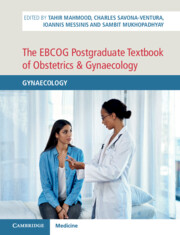Book contents
- The EBCOG Postgraduate Textbook of Obstetrics & Gynaecology
- The EBCOG Postgraduate Textbook of Obstetrics & Gynaecology
- Copyright page
- Dedication
- Contents
- Videos
- Contributors
- Preface
- Section 1 Basic Sciences in Gynaecology
- Section 2 Menstrual Disorders
- Section 3 Reproductive Endocrinology and Infertility
- Section 4 Contraception and STIs
- Section 5 Post-Reproductive Care
- Section 6 Vulva and Vagina
- Section 7 Cervix
- Section 8 Uterus
- Section 9 Ovary and Fallopian Tubes
- Section 10 Operative Gynaecology
- Section 11 Public Health Issues in Gynaecology
- Section 12 Miscellaneous
- Chapter 58 Prophylactic Bilateral Salpingo-oophorectomy
- Chapter 59 Immunotherapy for Gynaecological Cancers
- Chapter 60 Radiotherapy for Gynaecological Cancer
- Chapter 61 Clinical Audit and Risk Management in Gynaecology Practice
- Chapter 62 Research in Obstetrics and Gynaecology
- Chapter 63 Skills Training and Simulation
- Chapter 64 Practical Medical Education Science for Clinical Teaching Sites
- Chapter 65 Algorithm for Managing Vulvovaginal Symptoms
- Index
- Plate Section (PDF Only)
- References
Chapter 59 - Immunotherapy for Gynaecological Cancers
from Section 12 - Miscellaneous
Published online by Cambridge University Press: 24 November 2021
- The EBCOG Postgraduate Textbook of Obstetrics & Gynaecology
- The EBCOG Postgraduate Textbook of Obstetrics & Gynaecology
- Copyright page
- Dedication
- Contents
- Videos
- Contributors
- Preface
- Section 1 Basic Sciences in Gynaecology
- Section 2 Menstrual Disorders
- Section 3 Reproductive Endocrinology and Infertility
- Section 4 Contraception and STIs
- Section 5 Post-Reproductive Care
- Section 6 Vulva and Vagina
- Section 7 Cervix
- Section 8 Uterus
- Section 9 Ovary and Fallopian Tubes
- Section 10 Operative Gynaecology
- Section 11 Public Health Issues in Gynaecology
- Section 12 Miscellaneous
- Chapter 58 Prophylactic Bilateral Salpingo-oophorectomy
- Chapter 59 Immunotherapy for Gynaecological Cancers
- Chapter 60 Radiotherapy for Gynaecological Cancer
- Chapter 61 Clinical Audit and Risk Management in Gynaecology Practice
- Chapter 62 Research in Obstetrics and Gynaecology
- Chapter 63 Skills Training and Simulation
- Chapter 64 Practical Medical Education Science for Clinical Teaching Sites
- Chapter 65 Algorithm for Managing Vulvovaginal Symptoms
- Index
- Plate Section (PDF Only)
- References
Summary
Gynaecological cancers comprise a huge variety of tumours. In the three main organs (endometrium, cervix and ovary), tumours differ in biology and molecular features, explaining the differences in tumour behaviour. However, in all of them, effective treatment options for advanced disease are urgently needed. Immunotherapy could be one such strategy. The goal of immunotherapy is to promote antitumour immune responses by stimulating the host immune system, by enhancing immune response, by relieving immune suppression by the host immune system or by immunomodulation.
Until now, immune checkpoints inhibitors that modulate one of the most important pathways of tumour immune escape presented the most robust efficacy data, but many trials are still ongoing and are expected to provide important knowledge in the coming years.
In future, clinicians will be able to recognize immunotherapy toxicities early on and better deal with them, while appropriate patient selection for these therapeutics will allow a more personalized treatment approach.
- Type
- Chapter
- Information
- The EBCOG Postgraduate Textbook of Obstetrics & GynaecologyGynaecology, pp. 503 - 512Publisher: Cambridge University PressPrint publication year: 2021

